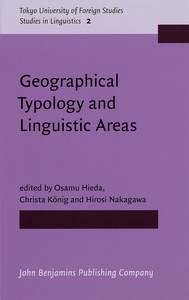Areal features and linguistic areas: contact-induced change and geographical typology
Aikhenvald, Alexandra (2011) Areal features and linguistic areas: contact-induced change and geographical typology. In: Hieda , Osamu , König, Christa, and Nakagawa, Hirosi, (eds.) Geographical typology and linguistic areas: with special reference to Africa. Tokyo University of Foreign Studies: studies in linguistics , 2 (2). John Benjamins Publishing Company, Amsterdam, The Netherlands, pp. 13-39.
![[img]](https://researchonline.jcu.edu.au/16611/2.hassmallThumbnailVersion/16611_Aikhenvald_2011_Book_Cover.jpg)
|
Image (JPEG) (Book Cover)
- Cover Image
Download (192kB) |
|
|
PDF (Published Version)
- Published Version
Restricted to Repository staff only |
Abstract
[Extract] What are the reasons for similarities between languages? Linguistic categories can be similar because they are universal-for instance, every language has some way of asking a question or framing a command. Occasionally, two languages share a form and meaning combination by pure coincidence. Goemai (Angas-Goemai subgroup of Chadic, Afroasiatic: Birgit Hellwig, p.c.) and Manambu, a Ndu language of the Sepik area, happen to use a:s for 'dog'. The word for 'tail' in Kwoma, from the Sepik area, is kinyi 'tail', and that in Manambu is gǝñ-a spurious similarity with Yidiñ (Australian) gini 'penis' is striking. And numerous languages of the world have a negator ma:, just like Manambu, or unrelated Tariana, an Arawak language from Amazonia. Distribution of typological features can vary in significance. Marked nominative systems are concentrated in eastern Africa. In the border region of Uganda, Kenya, Ethiopia and Sudan, nearly all the languages-both Nilo-Saharan and Afroasiatic-with case-marking display this pattern. It is extremely likely that this shared pattern results from diffusion and numerous instances oflanguage contact, and may be considered an areal property (König 2008a, 2008b). König hypothesizes that the direction of spread of marked nominative-patterns was predominantly from Afroasiatic languages into Nilo-Saharan languages. That Berber languages spoken to the north of the cluster of marked nominative languages also have a marked nominative system is significant: the pervasiveness of this property in Berber points to its antiquity in Afroasiatic.
| Item ID: | 16611 |
|---|---|
| Item Type: | Book Chapter (Research - B1) |
| ISBN: | 978-90-272-0769-2 |
| ISSN: | 1877-6248 |
| Date Deposited: | 20 Sep 2011 00:56 |
| FoR Codes: | 20 LANGUAGE, COMMUNICATION AND CULTURE > 2004 Linguistics > 200407 Lexicography @ 100% |
| SEO Codes: | 97 EXPANDING KNOWLEDGE > 970120 Expanding Knowledge in Language, Communication and Culture @ 100% |
| Downloads: |
Total: 505 Last 12 Months: 10 |
| More Statistics |



